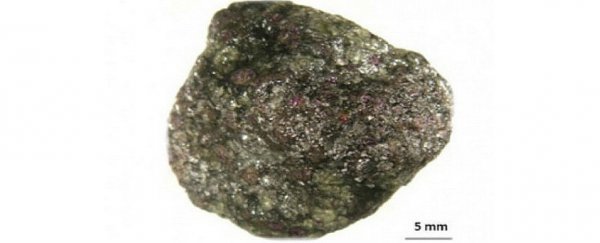A chunk of rock littered with 30,000 tiny diamonds has been found in a diamond mine in Russia. Researchers think that these thousands and thousands of gems formed all at once, and could hold the secret to how they form in nature.
The diamonds are considered worthless as gems due to their minuscule size, which means the rock was donated to researchers for analysis. The results were reported by geologist Larry Taylor from the University of Tennessee this week at the American Geophysical Union's annual meeting.
"The exciting thing for me is there are 30,000 itty-bitty, perfect octahedrons, and not one big diamond," said Taylor at the meeting. "It's like they formed instantaneously."
According to Becky Oskin at LiveScience, the concentration of diamonds found in the Udachnaya rock is several million times more than in an average diamond ore, which contains 1 to 6 carats (1 carat weighs about 0.2 of a gram) of diamonds per tonne. Taylor told her the chemical reactions that cause diamonds to occur in nature are still a mystery, and finds like this strange little nugget will help them to better identify and understand them.
Current understanding of diamond formation is that they develop deep below the surface of the Earth in the silicate rocky mantle layer. Chunks of rocks holding onto these gems are then forced up to the surface by volcanic eruptions, and all that heat ends up destroying the rock so just the diamonds remain. But somehow the Udachnaya rock made it through the volcanic ride without disintegrating.
Working with researchers at the Russian Academy of Sciences, Taylor analysed the rock using an industrial X-ray tomography scanner to figure out how it ended up with such a staggering amount of diamonds and remained intact. The X-rays cause each type of mineral to glow a different colour, and revealed that the diamonds form in a tight band running through the Udachnaya rock.
"The clear crystals are just 0.04 inches (1 millimetre) tall and are octahedral, meaning they are shaped like two pyramids that are glued together at the base," says Oskin at LiveScience. "The rest of the rock is speckled with larger crystals of red garnet, and green olivine and pyroxene. Minerals called sulphides round out the mix. A 3D model built from the X-rays revealed the diamonds formed after the garnet, olivine and pyroxene minerals."
The team also analysed the molecular make-up of the microscopic 'inclusions' in the diamonds, which turned out to be carbonate and garnet.
Taylor reported at the meeting on Monday that these diamonds were once fluids that seeped out of the Earth's oceanic crust when one tectonic plate moved to crush another one. These fluids then crystallised to form the diamonds.
"[The source] could be just a really, really old formation that's been down in the mantle for a long time," Sami Mikhail from the Carnegie Institution for Science in the US, who was not involved in the research, told LiveScience.
Source: LiveScience
